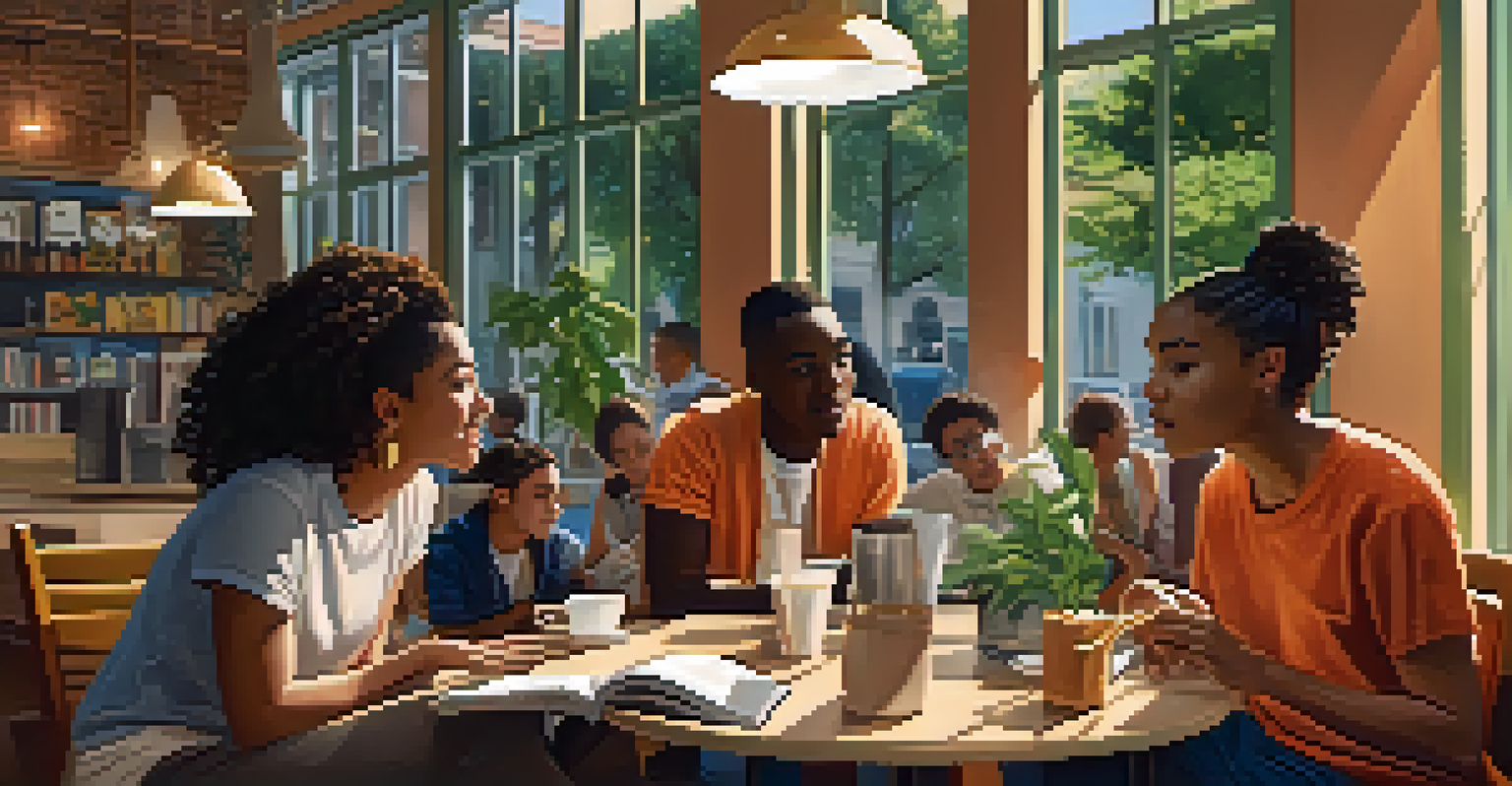The Impact of Film Adaptations on Literary Popularity Today

Film Adaptations: A Bridge Between Books and Audiences
Film adaptations serve as a vital link between books and wider audiences, introducing literary works to people who might not typically read. For example, the adaptation of 'The Fault in Our Stars' brought John Green's novel into the spotlight, leading to increased book sales and a surge in his readership. This phenomenon showcases how visual storytelling can breathe new life into classic and contemporary literature alike.
Books are a uniquely portable magic.
Moreover, the cinematic experience often makes stories more accessible, as viewers can enjoy a compelling narrative without the time commitment required for reading. This accessibility can ignite curiosity about the original texts, prompting audiences to seek out the books behind their favorite films. Ultimately, film adaptations can act as a catalyst for a renewed interest in literature.
However, it's essential to recognize that not every adaptation translates perfectly to the screen. Some viewers may be left disappointed if the film doesn’t capture the book’s essence. This divergence can lead to discussions that encourage readers to explore the source material, further enhancing the popularity of the literary work.
Increased Sales: The Ripple Effect of Adaptations
One of the most immediate effects of a successful film adaptation is the boost in book sales. After the release of the 'Harry Potter' films, J.K. Rowling's series saw a phenomenal increase in popularity, with millions of new readers flocking to the books. This trend illustrates how film adaptations can transform literary works into cultural phenomena.

Moreover, adaptations can revitalize older books that may have fallen out of public interest. For instance, after the release of 'Pride and Prejudice' adaptations, Jane Austen's works experienced a resurgence in popularity, attracting a new generation of readers. This process not only benefits the authors' estates but also introduces timeless stories to fresh audiences.
Adaptations Boost Book Popularity
Successful film adaptations can significantly increase book sales and renew interest in literary works.
The ripple effect extends beyond individual titles; it can also elevate entire genres. For example, the popularity of dystopian films has led to a surge in young adult literature focused on similar themes, showcasing how one successful adaptation can inspire a wave of new literary works and trends.
Cultivating a New Generation of Readers
Film adaptations often play a crucial role in cultivating a new generation of readers. Young audiences drawn in by visually stunning movies may find themselves eager to dive into the books that inspired them. This transition can foster a lifelong love of reading, as they discover the rich, nuanced worlds within the pages.
The best way to predict the future is to create it.
Take the 'To All the Boys I've Loved Before' series, for instance. The Netflix adaptation sparked interest not just in the films but also in Jenny Han's original novels, leading to a significant uptick in readership among teens. Such adaptations can serve as gateways, encouraging young viewers to explore literature beyond what they might typically encounter in school.
Additionally, the discussions generated by adaptations—whether through social media or book clubs—can motivate readers to engage with the text on a deeper level. These conversations help to create a community of readers who share insights and interpretations, enriching the overall reading experience.
Engaging with Themes: The Power of Visual Storytelling
Film adaptations have a unique ability to engage viewers with the central themes of a literary work through powerful visuals and performances. By bringing complex ideas to life, filmmakers can create an emotional connection that may resonate differently than the written word. This visual storytelling can deepen the audience’s understanding and appreciation of the source material.
For example, the adaptation of 'The Handmaid's Tale' not only illustrated Margaret Atwood's dystopian vision but also highlighted themes of feminism and power dynamics, prompting viewers to reflect on contemporary societal issues. Such interpretations can spark important conversations and inspire readers to explore the original text for further context and insight.
Visual Storytelling Engages Themes
Film adaptations use powerful visuals to engage audiences with the central themes of literary works, deepening their understanding.
However, it's crucial for adaptations to handle these themes thoughtfully. When done well, they can enhance the narrative; when mishandled, they risk oversimplifying complex ideas. This balance is vital for ensuring that audiences are encouraged to engage with both the film and the literature.
The Role of Nostalgia in Popularity
Nostalgia plays a significant role in the popularity of film adaptations, as many viewers are drawn to stories that resonate with their personal experiences or childhood memories. Adaptations of beloved classics, such as 'Little Women' or 'The Lion King,' often evoke a sense of familiarity, attracting audiences eager to relive those cherished moments through a modern lens.
This emotional connection can lead to increased interest in the original works, as fans seek to rediscover the stories that shaped their youth. For example, the release of 'The Great Gatsby' film adaptation reignited interest in F. Scott Fitzgerald's novel, prompting both old and new readers to revisit its themes of ambition and disillusionment.
Furthermore, nostalgia can create a buzz around adaptations, leading to heightened anticipation and excitement. The cultural conversations that emerge from these adaptations can drive readers to engage with the literature in meaningful ways, reinforcing the lasting impact of these beloved stories.
Challenges of Adaptation: Staying True to the Source
While film adaptations can significantly enhance the popularity of literary works, they also face the challenge of staying true to the source material. Fans of the original books often have strong opinions about how their favorite stories should be portrayed on screen. When filmmakers deviate too much from the source, they risk alienating die-hard fans and creating backlash.
A prime example is the adaptation of 'The Golden Compass,' which faced criticism for not capturing the depth of Philip Pullman's original novel. Such reactions can hinder the film's success and, in turn, affect the book's popularity. This highlights the delicate balance that filmmakers must maintain between creative interpretation and fidelity to the source.
Nostalgia Fuels Audience Connection
The emotional connection evoked by nostalgic adaptations often leads audiences to revisit and explore the original stories.
Despite these challenges, successful adaptations can elevate a book's status and broaden its audience. Filmmakers who manage to honor the essence of the original story while adding their unique touch often create adaptations that resonate with both fans and newcomers alike.
Cultural Impact: Shaping Literary Trends
The cultural impact of film adaptations extends beyond individual titles; they can shape literary trends and influence the types of stories that gain popularity. As audiences flock to films with specific themes or genres, publishers often take note and begin to produce more works that align with those interests. This dynamic relationship between film and literature can lead to a cycle of inspiration and innovation.
For instance, the success of fantasy adaptations like 'The Lord of the Rings' has spurred a surge in fantasy literature, inspiring authors to explore imaginative worlds and complex characters. This trend not only benefits writers but also enriches the literary landscape, providing readers with a wealth of new stories to discover.

Ultimately, the cultural conversations that arise from film adaptations can lead to a broader appreciation for literature as a whole. As audiences engage with these adaptations, they often seek out related works, fostering a vibrant reading culture that thrives on shared experiences and mutual interests.